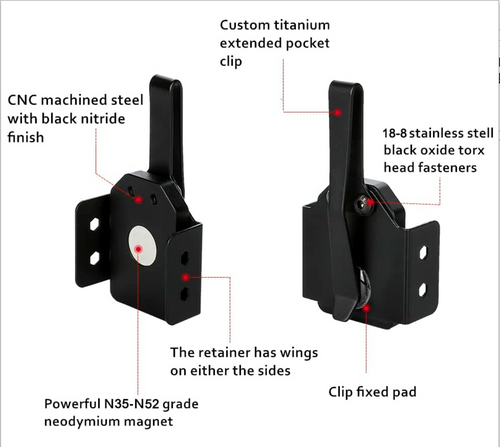When reholstering a firearm, slowing down can save lives. Rushing increases the risk of accidental discharges, injuries, and losing focus on your surroundings. Proper reholstering ensures safety, control, and situational awareness. Here’s what you need to know:
- Accidental Discharges: Quick movements can cause unintended trigger pulls.
- Injuries: Mishandling during reholstering can lead to preventable harm.
- Loss of Awareness: Rushing distracts you from potential threats nearby.
- Safe Techniques: Clear obstructions, check the holster path, and reholster deliberately.
Take your time, use controlled movements, and ensure your holster is designed for safety. These steps are essential for avoiding accidents and maintaining awareness.
How To Reholster Your Pistol Safely
Safety Risks of Quick Reholstering
Hurrying to reholster your firearm can lead to serious safety issues. It not only increases the risk of unintentional discharges but also diminishes your ability to stay aware of your surroundings. Here's a closer look at the dangers tied to quick reholstering.
Accidental Discharges
When you rush to holster your weapon, there’s a higher chance of causing an unintended discharge. Taking your time and maintaining control during this process is key to avoiding this hazard.
Potential Injuries
Improper control during a rushed reholstering can result in injuries that could have been avoided. Slowing down ensures your firearm is handled safely.
Loss of Awareness
Speeding through the reholstering process can cause you to lose focus on your environment, which is especially risky in high-stakes situations. Staying mindful during this action is essential for overall safety.
Benefits of Careful Reholstering
Rushing to reholster your firearm can lead to mistakes and accidents. Taking a more deliberate approach not only reduces risks but also improves safety and control.
Safety First
A slow and steady reholstering technique helps avoid accidents by keeping control of your firearm. It allows you to check for potential issues like:
- Finger placement errors
- Clothing getting in the way
- Misalignment with the holster
This extra attention not only minimizes risks but also ensures better handling overall.
Improved Weapon Control
Taking your time ensures you maintain a secure grip and proper alignment. This method helps you:
- Keep steady pressure and a clear path to the holster
- Detect resistance that might signal a problem
By staying in control, you reduce the chance of mishandling and can focus on assessing your surroundings.
Enhanced Situational Awareness
A measured approach to reholstering gives you the opportunity to stay aware of your environment. This means you can:
- Continuously scan for potential threats
- Decide if it’s the right moment to holster your weapon
- Plan your next steps carefully
Reholstering isn’t something to rush. Those extra seconds spent on proper technique can make all the difference in preventing accidents and maintaining both control of your firearm and awareness of your surroundings.
sbb-itb-7fb5bb8
Safe Reholstering Steps
A careful, step-by-step approach to reholstering is key to avoiding accidents and maintaining safety. Here's how to do it right.
Remove Obstructions
Before reholstering, clear anything that might get in the way. Use your support hand to move loose clothing out of the way. Specifically:
- Make sure drawstrings, shirt tails, and zipper pulls are away from the trigger guard.
Keep your trigger finger off the trigger while managing clothing to maintain full control.
Check Holster Path
Once obstructions are cleared, ensure your holster is ready. This involves:
- Visually confirming the holster mouth is open and free of obstacles.
- Checking that retention devices are properly positioned.
- Ensuring the holster hasn't shifted from where it should be.
- Verifying there’s no debris inside the holster.
If you carry inside the waistband, slightly tilt your hips away from the holster side for a better view of the holster opening.
Use Proper Speed
When you're sure the holster is clear and secure, reholster your firearm at a controlled, deliberate pace. Precision matters more than speed.
- Apply steady pressure and maintain visual focus as the firearm enters the holster.
- Stop immediately if you feel any resistance.
- Keep your eyes on the holster opening during the entire process.
Holster Features for Safe Use
Using proper reholstering techniques is important, but a well-designed holster adds an extra layer of safety. A good holster provides a stable and unobstructed opening, making reholstering secure and straightforward.
Houdini Holsters: Safety Features

The Breakout 2.0 IWB holster is built with a patent-pending design that balances comfort and durability. Its structure ensures the holster maintains its shape, allowing for smooth and secure reholstering every time.
| Safety Feature | Benefit |
|---|---|
| Custom Fit | Offers precise retention without extra material getting in the way. |
| Handcrafted Build | Ensures consistent quality and reliable safety. |
| Lifetime Guarantee | Provides confidence in its long-term performance and safety. |
Conclusion
Taking your time when reholstering helps prevent accidental discharges and keeps you mindful of your surroundings.
Safe reholstering requires intentional movements, a clear holster path, and staying alert to your environment.
The Houdini Holsters Breakout 2.0 IWB holster, featuring its patent-pending design, showcases how smart engineering can improve firearm safety.




